
[Title] [text TOC] [image TOC] [Site Search]
 [Donation]
[Donation]

 [Donation]
[Donation]
 |
Wood Carving |  |
|---|
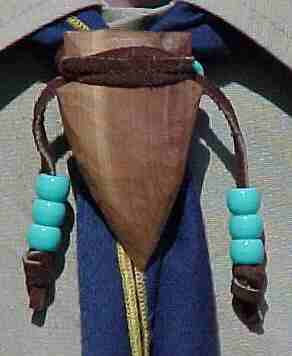 Arrowhead |
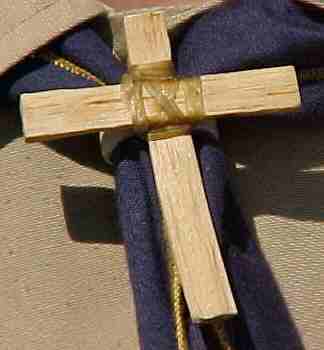 Cross |
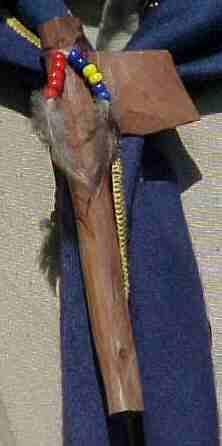 Axe |
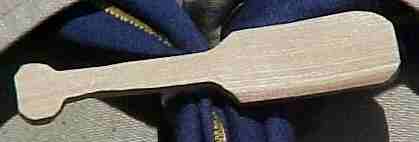 Paddle |
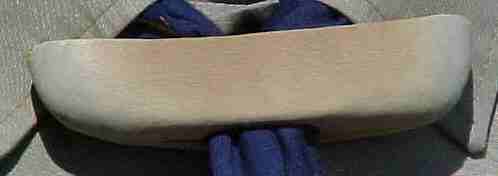 Canoe |
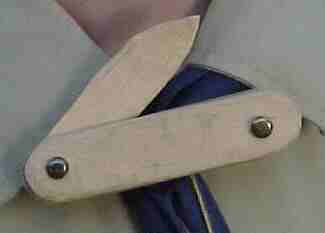 Knife |
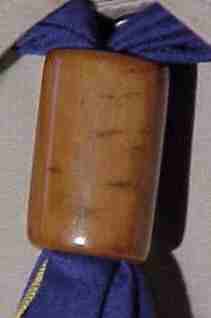 Wooden Tube |
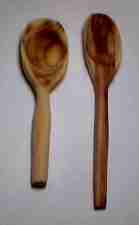 Spoon |
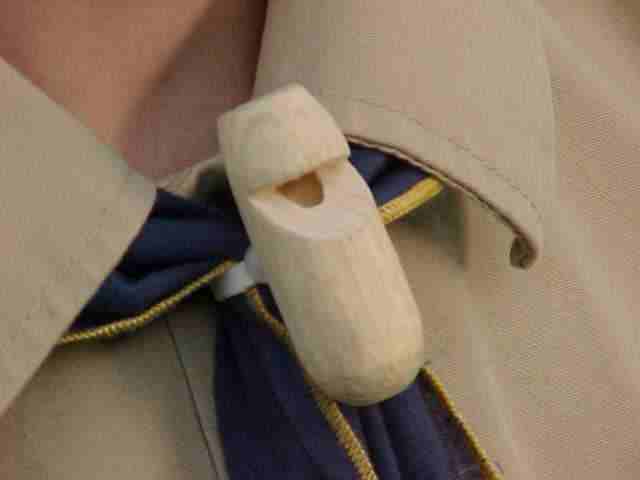 Whistle |
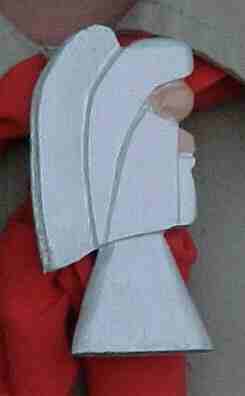 Angel |
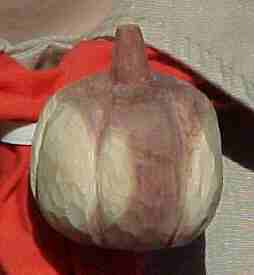 Pumpkin |
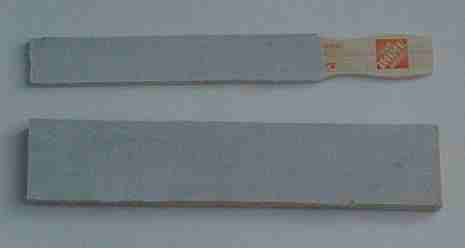 Strop |
 Pencil |
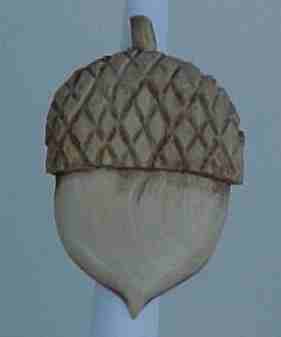 Acorn |
 Knife Sheath |
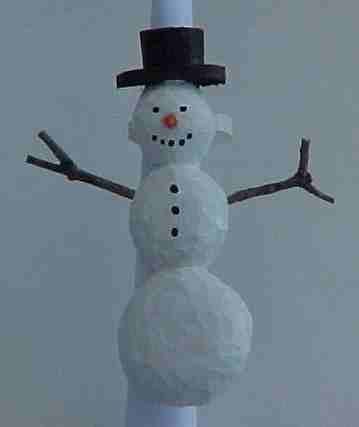 Snowman |
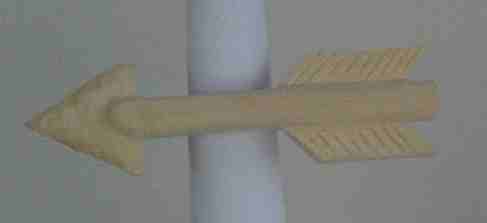 Arrow |
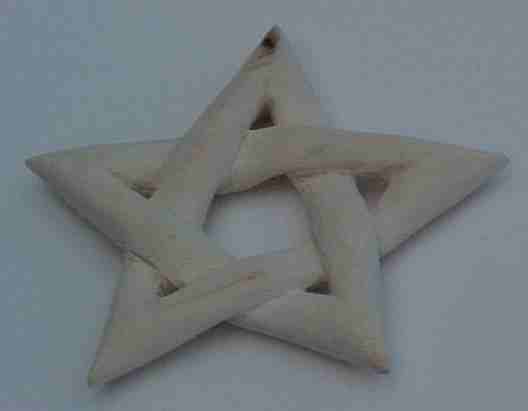 Star |
Are you ready for a challenge? In general, these projects require at least three hours and more tools to complete than the easy projects above.

Choose the type of wood you want to use. The material most widely used by carvers is basswood. It is available at specialty wood stores and some craft stores. It is relatively soft and easy to work. Aspen and poplar are similar. Butternut and catalpa are relatively easy to work and have pretty grain. Mahogany has a very attractive color and grain. Don't use balsa as it is too soft. Pine is widely available, but is harder to work than basswood. Cedar is a very pretty wood but it is more difficult to work.
You might try some limbs that are broken off by a storm or cut off by trimming. Wood found on the ground may be too rotten or full of imperfections to work well.
You will find that cutting with the grain will be easy. Cutting across or against the grain will be much more difficult.

Only very experienced wood carvers can work without drawing a pattern on the wood before they start. First, examine the wood and determine which way the grain runs. You want to orient the project on the wood so most of your carving is with the grain of the wood since that is easier. For example, if you are carving an arrowhead, you want the grain of the wood to run the length of the arrowhead, through the point. The most common method of laying out a project is to draw the outline on the wood with a pencil. You can also make a copy or template, cut it out and glue it to the wood using Elmer's Craft Bond™. This is a spray glue. If you let it dry on the template for a couple minutes before applying it to the wood, you can later peel the paper off. Another option is a glue stick. It's not as messy as the spray, but the template will be harder to remove. If you use a white glue, you'll have to either cut or sand the template off. Peeling is much easier. Another technique is to place the Xerox™ copy print side down and iron it onto the wood. The copier ink will stay on the wood. The image will be reversed. Rubber stamps and line drawn clip art are good sources of templates.
Once you have drawn the outline and interior lines, draw centerlines and other reference lines as needed. As you are working, re-draw lines as needed to help you.
Draw a middle-line around the sides before starting. Use your fingers to help keep a constant line centered between the front and back. This line will often make it easier later on when you are rounding edges.
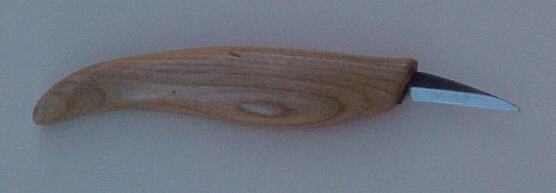
A small straight blade about 1 1/2" long is best because it is more agile in making small cuts and the straight blade is easier to sharpen. Small pocketknives are okay, but a detail carving knife is best because the bevel is a smaller angle which makes it cut easier. These are available at some wood working stores and craft stores. Save the large pocketknives for removing large amounts of wood.
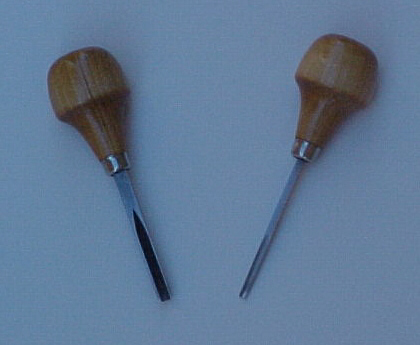
V and U shaped gouges are nice to have for projects that require hair or creases. But they are not necessary for most beginner projects. They come in a variety of widths and amount of curvature. Broad flat gouges are used to remove lots of wood because they use the much larger muscles of the arm and shoulder instead of the much smaller muscles of the hand (which is what you would use if you removed the same wood with a knife).

Carving with a sharp knife is fun, carving with a dull knife is work! A sharp knife is safer because it doesn't catch on the wood as easily. A whetstone with coarse and fine sides is best. Put a little water on it first. Then hold the knife blade flat on the coarse side of the stone with the back edge of the blade slightly elevated. Try to slice off a thin piece of the stone. Move in one direction several times then flip the knife over and do the same on the opposite side. Keep alternating the sides. If you hold a blade edge to a light (the sun works best or use a single source light bulb not fluorescent tubes), you will see a glint of light off the edge where the blade is dull. Keep sharpening until you remove all the dull, shiny spots and then use the fine side of the whetstone.
If the blade edge is curved at the tip, instead of pushing the blade straight across the stone, move it in an arc. This will sharpen the point.
Once you have a sharp edge on the blade, you should be able to keep it sharp by occasionally using an extra fine diamond hone sharpening stone (about 1200 grit) and stropping.
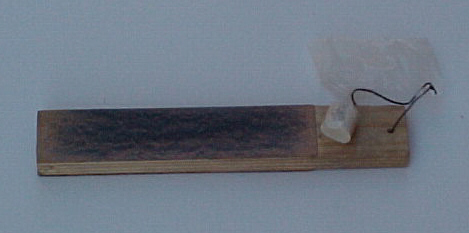
You can buy a strop or make a strop by gluing a piece of tanned leather (fuzzy side up) to a flat board. Add an abrasive like Yellowstone™. To use the strop, place the knife blade on the strop as you did in sharpening. On a strop, pull the blade (move the blade backwards) so it doesn't cut into the leather. Run it a few times on one side then flip it over and do the same on the opposite side until the blade drags across it smoothly. I always like to strop a knife before I use it and once or twice per hour while carving. Once a knife is sharp, you should ONLY need to strop it to keep it sharp unless something drastic happens like you drop it. I've used the same knife for a year without ever having to do anything but strop it and it is still razor sharp.
Pay special attention to the tip of the blade. The front 1/2" gets a lot more use especially if you are doing detail carving. You'll probably want to strop it more.
If you are stropping a folding knife, be very careful that the blade doesn't fold up on your hand. Place a finger or thumb on the very base (not sharp) of the blade to hold it in place.

I frequently find myself disobeying one of the main rules of knives -- don't cut towards yourself. Usually, I am using my thumb as a stop for the blade. This is a very natural method to carve. It allows for a lot of control and power. However, after cutting myself several times, I decided to do something about it. The solution that I came up with is a leather thumb sheath. This way when the knife slips into your thumb, it hits the leather and cuts it instead of your thumb. The sheath is constructed of thick leather (1/8"). The sheath should be rectangular and wrap around most, but not all of the thumb. Punch a hole in the two ends of the sheath and loop a leather thong through the holes and tie it in an overhand knot. Place the sheath on the thumb of your cutting hand and use your other hand and mouth to tighten the thong.
Also, you can use several wraps of duct tape (see red one in photo below) or masking tape. These should cover at least up to the first joint of your thumb. Use about ten pieces of tape about one inch wide and six inches long. If you place a Popsicle stick or something about that size on your thumb first, it will be loose enough you can slip it off and reuse it. Wrap the first piece of tape loosely around your thumb sticky side out. Use a second one to cover past the first joint of your thumb. Take a third piece sticky side out and attach the end of it to the base on the top of your thumb and run it over the tip of your thumb and back down the bottom. Take the remaining pieces of tape and wrap them around your thumb sticky side down trying to cover all the sticky parts. When the tape gets too worn, just add a few more layers or make a new one.
They also make a tacky gauze that is very effective. Just wrap it around and around your thumb being sure to cover it with several layers. Use a Popsicle stick as indicated above to make it a little looser for easier removal.
Another option is to use the fingertip of a leather glove. Sew a piece of elastic near the base to help keep it in place. Some wood carvers wear a leather or Kevlar glove on their other hand. Both thumb sheaths and gloves are available commercially.

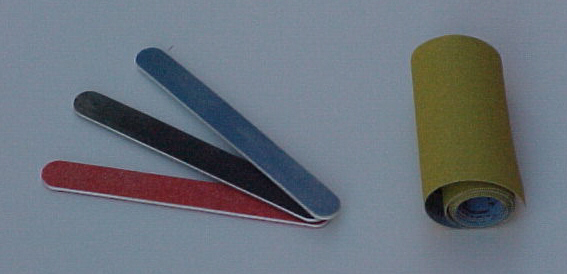
Sandpaper is great for erasing small mistakes made in carving. It comes in various grades. Low numbers like 60 are coarse and rough; high numbers like 400 are fine and smooth. Most of your work will be with the coarse grades. Only move to finer grades when all blemishes are removed with the coarse. If you can't remove a blemish, use a coarser grade of sandpaper. If you don't have any coarser sandpaper, it's time to get your knife out and correct the problem.
Swiss sandpaper is the best because it lasts a long time. It has a cloth backing which allows it to bend more easily than paper backings. It is available in rolls about 4" wide and 3' long.
For small projects, you need a small sand block. Emery boards (used for smoothing fingernails and found in drug stores) make very convenient sand blocks. They come in various roughnesses and are inexpensive. Get the ones that are about 1/8" thick. They are stiffer and easier to use than the ones that are very thin.
Riffler files are another option. They come in various shapes and are a good option for the first coarse sanding. They don't deteriorate like sandpaper. The pointed ones are especially good at getting into small spaces.
You can also make small sanding blocks by wrapping a narrow piece of sandpaper around a Popsicle stick or various sizes of dowel rod (they are easier to get into curves). For a more permarent solution glue the sandpaper onto a piece of wood at least 6" long with white glue. For flat sanding blocks, just place a weight on top until the glue dries. For round sanding blocks hold the sandpaper in place by wrapping it with masking tape. Use coarse sandpaper, then if you need to use finer sandpaper, you can just wrap it around and hold it in place with your fingers. The roughness of the coarse sandpaper will help hold the fine sandpaper in place.
Flexible sanding pads like 3M™'s Sandblaster are great for smoothing out curves. Since most of the projects I work on are small, I cut the pads into 1" x 2" rectangles. Make your own flexible sanding pad by gluing your favorite sandpaper to a piece of non-slip ribbed plastic shelf liner (also sold as carpet pads) with E-6000™ glue.
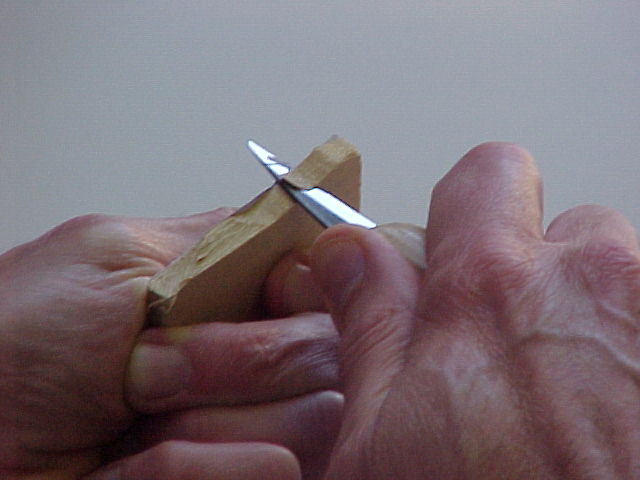
This is a very strong cut, but you don't have very much control over the blade. Get a firm grip on the knife close to the blade and push away from your body. It is used more for whittling than carving. Watch the fingers of the hand holding your project and your legs so they don't get in the way.
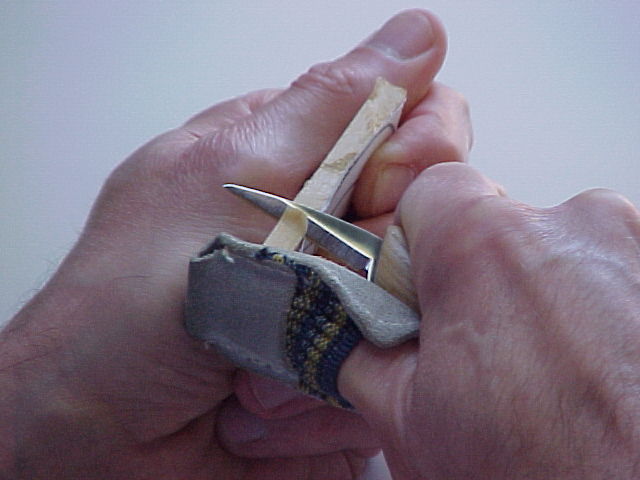
This is probably the most often used technique because of the control you have of the blade. This will be towards your thumb, so wear a thumb guard.
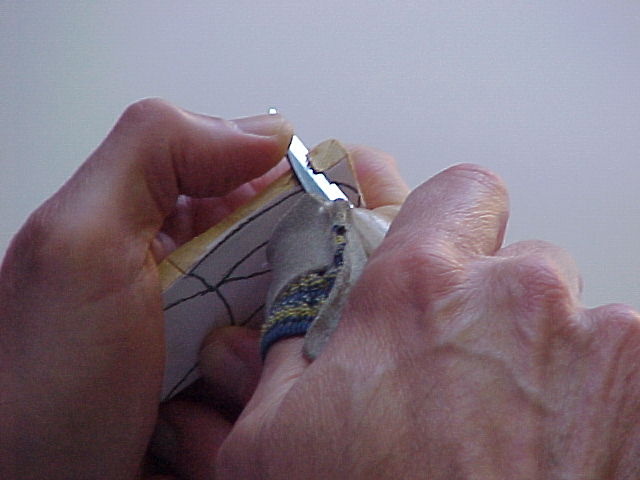
This is a stronger cut because you are using both hands and you have lots of control of the blade. Place the thumb of the hand not holding the knife in the middle of the blade. Push with both hands. A slight variation of this is to use the thumb as a fulcrum and the knife as a lever. Hold your thumb rigidly against the back of the blade. Pull the handle of the knife towards you. This works like an old style can opener.
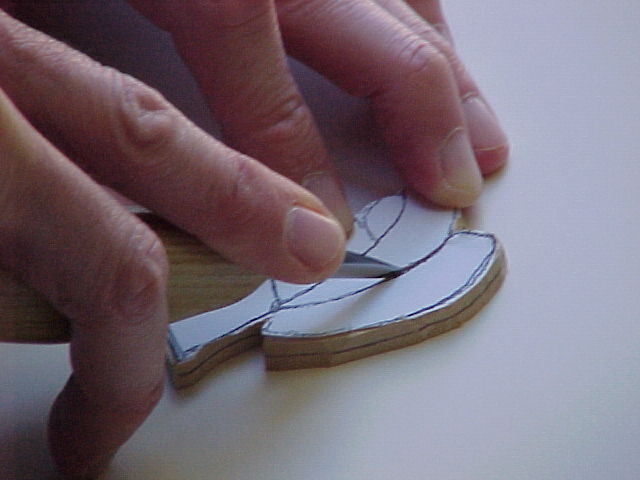
This cut is usually straight down into the wood. It allows you to cut away the wood on one side to get a sharp edge exactly where you want it.

This cut is used to create a visible line. Make a stop cut first, then cut at an angle for a single notch, cut at an angle from the other side of the stop cut for a V notch. If you have to take a lot of wood off to indent a surface, you may have to make a series of stop cuts and angle cuts.
Use larger brushes for painting large areas and small pointed paintbrushes for details. Toothpicks are handy for making dots like eyes. Permanent markers are good for making thin lines.
To get a good glossy finish it is necessary to first prepare the surface and get it as smooth as possible using very fine (400 to 600 grit) sandpaper. An old toothbrush is handy for removing fuzz and dust from small spaces. Wipe the surface with a tack cloth to remove any remaining dust. Apply the finish and set it to dry in a place where it won't get dusty. Since the finish has a odor, you may want to do this outside or in a garage. Hanging the item can be a challenge. I like to use pushpins placed in the bottom of the item. Then use a spring clothespin to either act as a base for sitting on a table or to hang it on a line. Put on multiple coats (four or more) and wait until the finish is completely dry before applying the next coat. If you notice blemishes in the finish, rub them gently with 0000 steel wool.
To start off, I would suggest a detail knife like the Flexcut™ KN-13. As you gain experience and learn new techniques, you'll want to get more specialized tools. They will help you do things faster, cleaner, and with better looking results. Notice the tools that other carvers use. They will probably even let you try them out. Build your tool set slowly instead of buying a set of tools, many of which you may not use. But to start out, just get a detail knife.
If your hand or arm gets tired while carving, take a short break. Put your knife down, and get up and walk around. Get a drink of water. Stretch, flex, and move your hand and arm around for a couple minutes.
One common beginner mistake is to not carve enough and leaving the project looking too much like the original block of wood.
How do you know when you are finished carving a project? You never are finished, you just stop working on it.
Try to locate a local wood carving club. The amount you learn from participating in these clubs is amazing. Check the Internet. Also, check senior centers, community centers, and colleges. Many will have classes in wood carving. All you have to do is stop by and talk to them about local clubs.
Younger children (under 13) may have a difficult time carving wood. They may not have the hand or arm strength required. One thing I have done is to make Plaster of Paris blocks for them to carve. Have the children sharpen a store bought pencil as a first project with wood. They will get a real kick out of being able to do something useful.
I've only been carving seriously since late 2005, so as I learn more I'll update these pages.
Resources:
Whittling with Ben Hunt by Ben Hunt
A Beginner's Book of Carving Neckerchief Slides, Pins and Magnets by Robert Reitmeyer
Smoky Mountain Woodcarvers - Sharpening directions, supplies, and much more
The Woodcraft Shop - Great catalogue